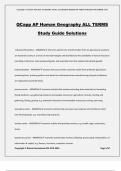Copyright © KAYLIN 2024/2025 ACADEMIC YEAR. ALL RIGHTS RESERVED FIRST PUBLISH NOVEMBER, 2024
QCapp AP Human Geography ALL TERMS
Study Guide Solutions
Industrial Revolution - ANSWER✔✔-the term used for the transformation from an agricultural society to
an industrial society as a result of new technologies and facilitated by the availability of natural resources
(resulting in factories, mass-produced goods, and assembly lines that replaced handmade goods)
industrialization - ANSWER✔✔-process that occurs when countries evolve from primarily agricultural
producing basic, primary goods to one based on mechanized mass manufacturing of goods (craftsmen
are replaced by assembly lines)
primary sector - ANSWER✔✔-economic activity that involves extracting (raw materials) or harvesting
(food) products, e.g. gathering industries (renewable resources): agriculture, forestry, hunting and
gathering, fishing, grazing, e.g. extractive industries (nonrenewable resources): mining, quarrying
secondary sector - ANSWER✔✔-economic activity that processes raw materials and transforms them
into finished goods, e.g. manufacturing industries
tertiary sector - ANSWER✔✔-economic activity that provides services, e.g. health, legal, restaurants,
stores
quaternary sector - ANSWER✔✔-economic activity that involves collecting, processing & manipulation of
information & capital, e.g. finance, insurance, computer services
Copyright © Stuvia International BV 2010-2024 Page 1/52
, Copyright © KAYLIN 2024/2025 ACADEMIC YEAR. ALL RIGHTS RESERVED FIRST PUBLISH NOVEMBER, 2024
quinary sector - ANSWER✔✔-economic activity consisting of high-level decision making and
advancement of human capacities, e.g. scientific research, higher education, government
core - ANSWER✔✔-countries where economic power (wealth, innovation, technology) is concentrated
that control and benefit from the global market on which periphery and semi-periphery countries
depend, e.g. U.S., Western European countries, Canada, Australia, Japan
semi-periphery - ANSWER✔✔-countries that are industrializing that exert more power in the world
economy than the periphery, but are dominated to some degree by the core, e.g. newly industrialized
countries such as Brazil, Russia, India, China, South Africa, Turkey
periphery - ANSWER✔✔-countries with low levels of economic productivity and a disproportionately
small share of the world's wealth with weaker state institutions, lower standards of living and are often
dependent on the core, e.g. Sub-Saharan African countries (except South Africa), parts of South America
and Asia
break of bulk point - ANSWER✔✔-the transfer of transported cargo from one kind of carrier to another,
e.g. port- from ship to truck
Least Cost Theory - ANSWER✔✔-Alfred Weber, theory that describes the optimal location of an industry
in relation to costs of transport, labor, and relative advantages of agglomeration, an industry is located
where it can minimize its costs, and therefore maximize its profits
agglomeration - ANSWER✔✔-the clustering of businesses that can benefit from close proximity because
they share skilled-labor and customer base
Copyright © Stuvia International BV 2010-2024 Page 2/52
, Copyright © KAYLIN 2024/2025 ACADEMIC YEAR. ALL RIGHTS RESERVED FIRST PUBLISH NOVEMBER, 2024
footloose industries - ANSWER✔✔-industry in which the location is not impacted by the cost of
transporting either raw materials or finished products
LDC (less developed country) - ANSWER✔✔-countries with low levels of industrialization, urbanization
and low standards of living that are mainly focused on primary activities, predominantly agriculture
NIC (newly industrialized country) - ANSWER✔✔-less developed countries with growing industrial
economies and a developing trade status in the global marketplace (BRICs: Brazil, Russia, India, China,
South Africa)
MDC (more developed country) - ANSWER✔✔-countries with highly developed economies, high levels of
industrialization, urbanization, advanced technological infrastructure and high standards of living
post-industrial society - ANSWER✔✔-a society in which the economy has transitioned from a
manufacturing-based economy to a service-based economy
GDP (gross domestic product) - ANSWER✔✔-measurement of the total value of goods and services
produced within the borders of a country during a specific time period, usually one year
GNP (gross national product) - ANSWER✔✔-measurement of the total value of goods and services
produced within the borders of a country plus the net income from companies that are located outside
the country and foreign investments during a specific time period, usually one year
GNI per capita (gross national income per capita) - ANSWER✔✔-measurement of the total value of
goods and services produced within the borders of a country plus the net income from companies that
Copyright © Stuvia International BV 2010-2024 Page 3/52
, Copyright © KAYLIN 2024/2025 ACADEMIC YEAR. ALL RIGHTS RESERVED FIRST PUBLISH NOVEMBER, 2024
are located outside the country and foreign investments, but minus dividend payments and indirect
business taxes during a specific time period, usually one year, divided by the population
Gini coefficient - ANSWER✔✔-measurement of income distribution within a population
fertility rate - ANSWER✔✔-the average number of children a woman will have during her childbearing
years (15-49)
infant mortality rate - ANSWER✔✔-number of deaths under one year of age per 1,000 live births during
a given year
access to health care - ANSWER✔✔-refers to the ease with which an individual can obtain needed
medical services
literacy rate - ANSWER✔✔-percent of population who can read and write
gender inequality - ANSWER✔✔-acknowledges that gender affects an individual's lived experiences;
gender inequality is experienced across different cultures; tradition and culture pose obstacles to
women's economic development, especially in less developed countries
GII (gender inequality index) - ANSWER✔✔-measurement that evaluates women's status in a country
based on participation in economic, political, and labor-market participation, as well as reproductive
health issues, indices of empowerment, and labor-market participation
HDI (human development index) - ANSWER✔✔-measurement used by the United Nations to calculate
development in terms of human welfare (using both economic and social indicators)
Copyright © Stuvia International BV 2010-2024 Page 4/52




